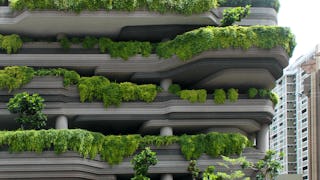Our streetscape, despite its feeling of permanence in our environment, is an ideal venue for experimentation. We have come to accept traffic movement as the default function for the street. Therefore, we need to rethink its design and space distribution, go back to its original and basic function and see them as public spaces - Transform them into places for social activities, where conversations can take place and places where kids can play. This course shows you examples of remarkable changes and gives you a toolbox for implementing and evaluating street experiments yourself. We invite you on this journey to reimagine what is possible if we dare to use our public space differently.


Enjoy unlimited growth with a year of Coursera Plus for $199 (regularly $399). Save now.


Street Experiments for Sustainable and Resilient cities


Instructors: Benjamin Büttner
2,790 already enrolled
Included with
(42 reviews)
Recommended experience
What you'll learn
You'll learn how cities implement and evaluate different types of street experiments to improve the livability of neighbourhoods
Skills you'll gain
Details to know

Add to your LinkedIn profile
See how employees at top companies are mastering in-demand skills

There are 4 modules in this course
This week, we will explore how the COVID-19 pandemic served as a catalyst to open people's thinking about using streets for more social purposes and answer the question, "can functions of mobility and public space co-exist and simultaneously increase the liveability of cities?" We will visit a brief history of the evolution of streets, both in concept and using historical examples, and see how ideology influences people's willingness to reshape the street for different functions. Surprisingly, even automakers see the limitations of cars and are taking steps to hedge against different mobility futures by investing in street experiments and shared mobility.
What's included
5 videos9 readings1 assignment2 plugins
This week, we go around the world to see practical examples of street experiments in action. In doing so, we see how experiments can be categorized into 4 different typologies in ascending functional complexity: simple street re-markings, alternative uses of parking spaces, reconversion of sections of streets, and the opening of entire streets to uses other than motorized traffic. We then pose the question, "How can tactical urbanism help create healthier streets?" leading us to find that bottom-up initiatives can be powerful instigators of change.
What's included
3 videos2 readings1 assignment3 plugins
This week explores how street experiments are implemented, from start to finish, and we will learn about the challenges along the way. We find that street experiments are often the starting point for the transition of public space, and these experiments give people the chance to experience, to really feel the changes immersively, rather than just seeing plans on a board. We learn how to approach strategic problems by using tactical urbanism techniques, and how colorful and eyecatching spaces can do its own marketing. Finally, we make the connection between culture and street design, framing experiments in the context of "mobility culture" and asking us how real world laboratories can explore existing culture and explore new cultures.
What's included
4 videos3 readings1 assignment
This week, we ask "are we really challenging mobility systems with these relatively small scale experiments?" Despite all the colorful experimentation taking place around the world, not all experiments lead to permanent changes. We will explore how experiments can serve as short term actions through which alternative structure, cultures and practices are explored. We then look at the five characteristics of the city street experiments: Are they... radical, change-driven, feasible, strategic, and communicative? They are an initial step in the assessment framework since street experiments are so complex. Finally, we are challenged to involve citizens in the experimentation process, and you will learn that buy-in of the community is essential to the long-term success of making experiments permanent.
What's included
5 videos3 readings1 assignment1 peer review
Instructors

Explore more from Governance and Society
 Status: Preview
Status: PreviewUniversity of Amsterdam
 Status: Free Trial
Status: Free TrialJohns Hopkins University
 Status: Free Trial
Status: Free Trial Status: Preview
Status: PreviewUniversitat Politècnica de València
Why people choose Coursera for their career




Learner reviews
42 reviews
- 5 stars
83.33%
- 4 stars
16.66%
- 3 stars
0%
- 2 stars
0%
- 1 star
0%
Showing 3 of 42
Reviewed on Apr 22, 2022
course material is very useful and easy to understand

Open new doors with Coursera Plus
Unlimited access to 10,000+ world-class courses, hands-on projects, and job-ready certificate programs - all included in your subscription
Advance your career with an online degree
Earn a degree from world-class universities - 100% online
Join over 3,400 global companies that choose Coursera for Business
Upskill your employees to excel in the digital economy
Frequently asked questions
To access the course materials, assignments and to earn a Certificate, you will need to purchase the Certificate experience when you enroll in a course. You can try a Free Trial instead, or apply for Financial Aid. The course may offer 'Full Course, No Certificate' instead. This option lets you see all course materials, submit required assessments, and get a final grade. This also means that you will not be able to purchase a Certificate experience.
When you purchase a Certificate you get access to all course materials, including graded assignments. Upon completing the course, your electronic Certificate will be added to your Accomplishments page - from there, you can print your Certificate or add it to your LinkedIn profile.
Yes. In select learning programs, you can apply for financial aid or a scholarship if you can’t afford the enrollment fee. If fin aid or scholarship is available for your learning program selection, you’ll find a link to apply on the description page.
More questions
Financial aid available,
¹ Some assignments in this course are AI-graded. For these assignments, your data will be used in accordance with Coursera's Privacy Notice.



